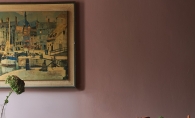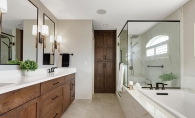Have you ever walked into a kitchen and stopped dead in your tracks, struck by the overwhelming beauty of a spectacular countertop?
Forget about pendant lights, bronzed faucets or dovetail joints, when it comes to the wow factor in a kitchen or bath, a cool countertop can steal the show. There are myriad options on the market so here is primer to help identify the kitchen focal point of your dreams.
When it comes to surface choices you can go from rustic to refined as easily as moving from 10 dollars a square foot to 10 dollars a square inch. But the prevailing material choice seems to be granite and quartz. For their beauty and movement of color, these natural stones offer a piece of practical art for the household cook. Along with being some of the hardest surfaces available, they now range widely in price with the advent of foreign direct suppliers.
“Countertops do make a difference! Especially in the kitchen,” says Coldwell Banker Burnet agent Donna Carlson. “Granite is the number one popular choice, just ahead of Cambria (a solid surface quartz material). Sometimes homeowners will change their countertops just to make the home more sellable.”
Choices, Choices
While you may have no plans to leave your present home, knowing what is most popular sometime gives a hint at what others have discovered about the desirability of certain surfaces. Quartz and granite are two countertops that are so dense you can actually use them as a cutting surface. With little to no permeability, they resist harboring bacteria. Marble is another natural surface that requires more maintenance but has a long history gracing kitchens from turn-of-the-century farmhouses to luxurious Italian villas. The traditional wood cutting block is a surface that brings warmth to an interior. However, it is the surface treatment (and retreatment) that makes wood usable in the long run. Steve Loughlin, manager at Pacific Granite in Maple Grove, says wood is more porous and each dent allows bacteria to enter. “It’s not as durable and doesn’t take heat, so it’s not as common.”
Another uncommon and highly “green” option is recycled glass. The color choices and visual interest created in a recycled glass countertop are endless. Along with soapstone, a rustic stone used for laboratory countertops which Loughlin says he installs only every other month or so, these highly unique surfaces can make your kitchen a conversation piece based on the countertop alone.
Sasha Andreyevskiy, owner of Granite One, mentions that 20 years ago laminate (a plastic made from resin and paper materials) was the number one countertop. “If you do not use the kitchen much, laminate is ok, but designwise it looks a lot cheaper,” he says. “It’s the least expensive option but the difference is not that much. Where it might cost $1,500 for laminate, only $2,500 will buy granite.”
If your budget allows you to slide to the high end of the scale, consider metal or cement. Loughlin says that stainless steel countertops are usually found in industrial kitchen atmospheres but the high-end shine of stainless appliances is simply not enough restaurant-like atmosphere for some aspiring cooks. Other cooks simply want a customized look like no one else in the neighborhood and cement delivers.
Poured to the exact shape, thickness and texture desired, a cement countertop can be colored to any hue, and items like shells, tiles or pictures can be imbedded in the surface or added under the sealant. While laminate may weigh 5 pounds per square foot and granite may be as heavy as 18 to 20 pounds per square foot, cement requires a reinforced cabinet strong enough to hold whatever 20+ pound thickness is poured.
If you’re looking for strength in a countertop with practically no maintenance, you’d do well looking at a solid surface material, often called Silestone, Caesarstone or Cambria, which is highly scratch, stain, heat and chip resistant. These forms of “man-made” quartz create a consistent look across an entire kitchen or bath because their surface design and colors can be controlled.
One much desired feature of a solid surface product, especially in a bathroom, is the option of having the sink and countertop made as one seamless piece. Another feature is the unique addition of metallic, raw stone-looking edge treatments and colors that are not found in nature. Imagine a cheery lemon yellow or midnight blue surface with silver specs glittering throughout.
Design Ideas
Once you have a good idea of the type of surface you favor, edging and color options help complete a design vision. The right edge profile is important to the overall look of a countertop.
Andreyevskiy and kitchen designer Leslie Copsey agree that the straight edge is still the most popular, with different degrees of easing on the corners. “It looks great in every space,” says Copsey. “The more intricate the edge, the less comfortable it is for a workspace or seating area,” she adds.
An edge treatment makes a countertop more comfortable to lean against and can bring extra style to a kitchen. “A bevel gives you two more distinct edges,” Loughlin says. He cautions against the use of a full bullnose edge where water runs off the edge, around, along the bottom of the counter and onto the cabinets below. “A rounded top edge with square bottom is the most durable,” he says.
Simple lines and patterns in a space can be highlighted by a more intricate edge, but Loughlin also points out that complex edges are more expensive and also weaken those countertops made of stone.
Color, Color on the Wall…
Pattern and color are critical to the visual impact and long-term viability of any kitchen or bathroom space. “What to some homeowners may be an artistic piece may seem a wreck to others,” Loughlin says. Most customers pick a neutral color that will work with anything. “[So] if you paint your walls two years later it won’t matter,” Andreyevskiy say.
In fact, “calmer patterns or no pattern at all” are becoming popular according to Copsey. “Textured tops are fantastic,” she says. “A slightly brushed surface in a plain color adds depth and is timeless.”
Andreyevskiy insures a good countertop choice by asking customers to bring in samples of their floor and wall colors. Until you can compare the materials side by side, it’s impossible to know how one surface choice may affect the look of another.
In the end, countertop choices really depends on your lifestyle.
Weeding Through the Choices
Overwhelmed by all the surface options? Here are some things to take into account that may help narrow your choices, courtesy of Leslie Copsey, co-owner and designer at SCC Kitchen Bath and Home:
Ease of cleaning
How much maintenance do you want to accept?
Stability of the underlying cabinetry
Stronger cabinetry can support heavier materials.
Size of the countertops needed
Cost per square foot and common sizes of specified materials make a big difference to a budget.
Visual choices
Countertops are permanent. Allot of movement in the color or pattern may sometimes be too busy for the space.
The size of the space
Busy patterns or colors can make the space appear smaller.
Long-range satisfaction
The length of the customer service warranty can help you feel more secure with what can be a hefty purchase.
Trends to Inspire
Some of the latest trends in kitchen and bath design include:
-Softer colors in earthy tones
-Less polished surfaces which add depth to the countertop
-Natural stone, deep veining and swooping lines, used on a kitchen island
-Quartzite as a natural, marbled-look alternative to less durable marble
-Differentiating perimeter countertops and center islands. A wild piece of granite is chosen for a center island and more subdued, complementary surfaces are used everywhere else.
-Choosing a different edge treatment on an island. Ornate edge treatments provide a traditional, classic look while simple edge treatments evoke a contemporary feel.









